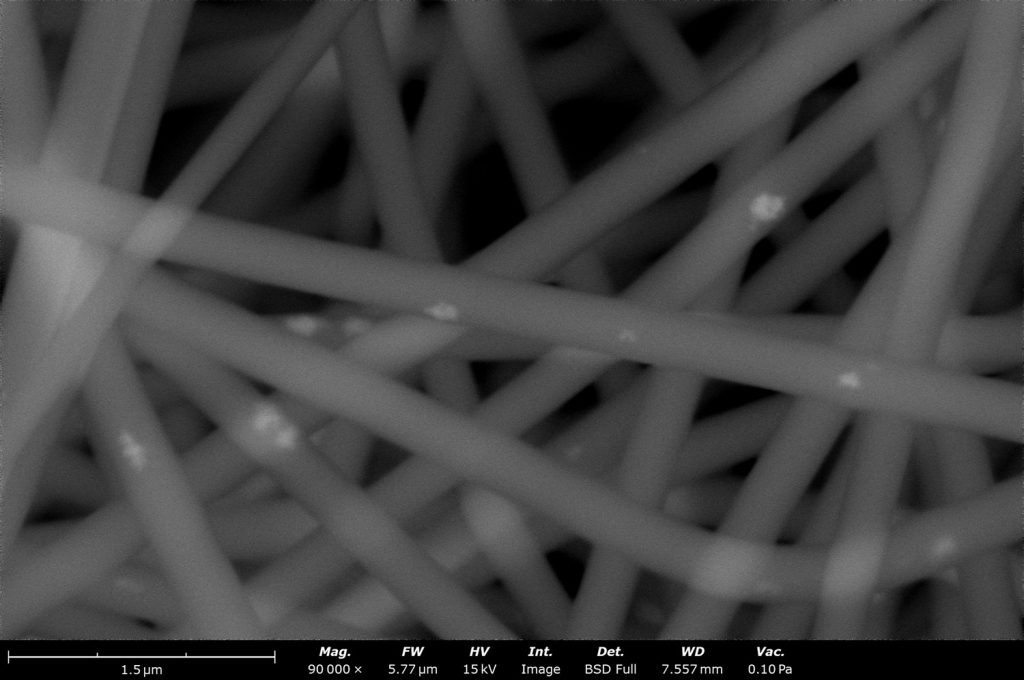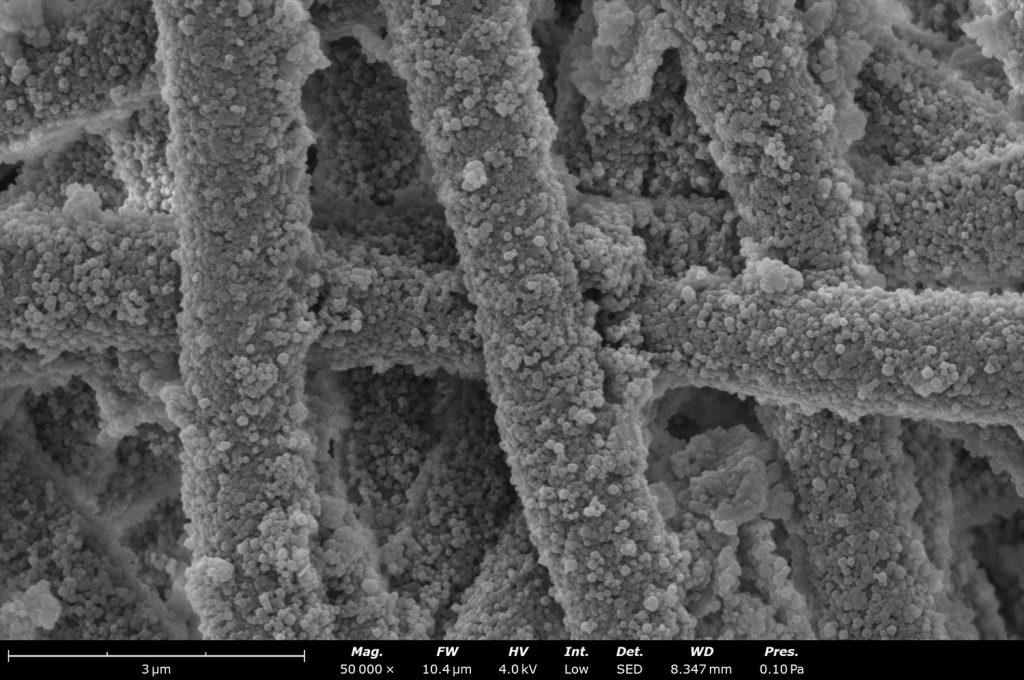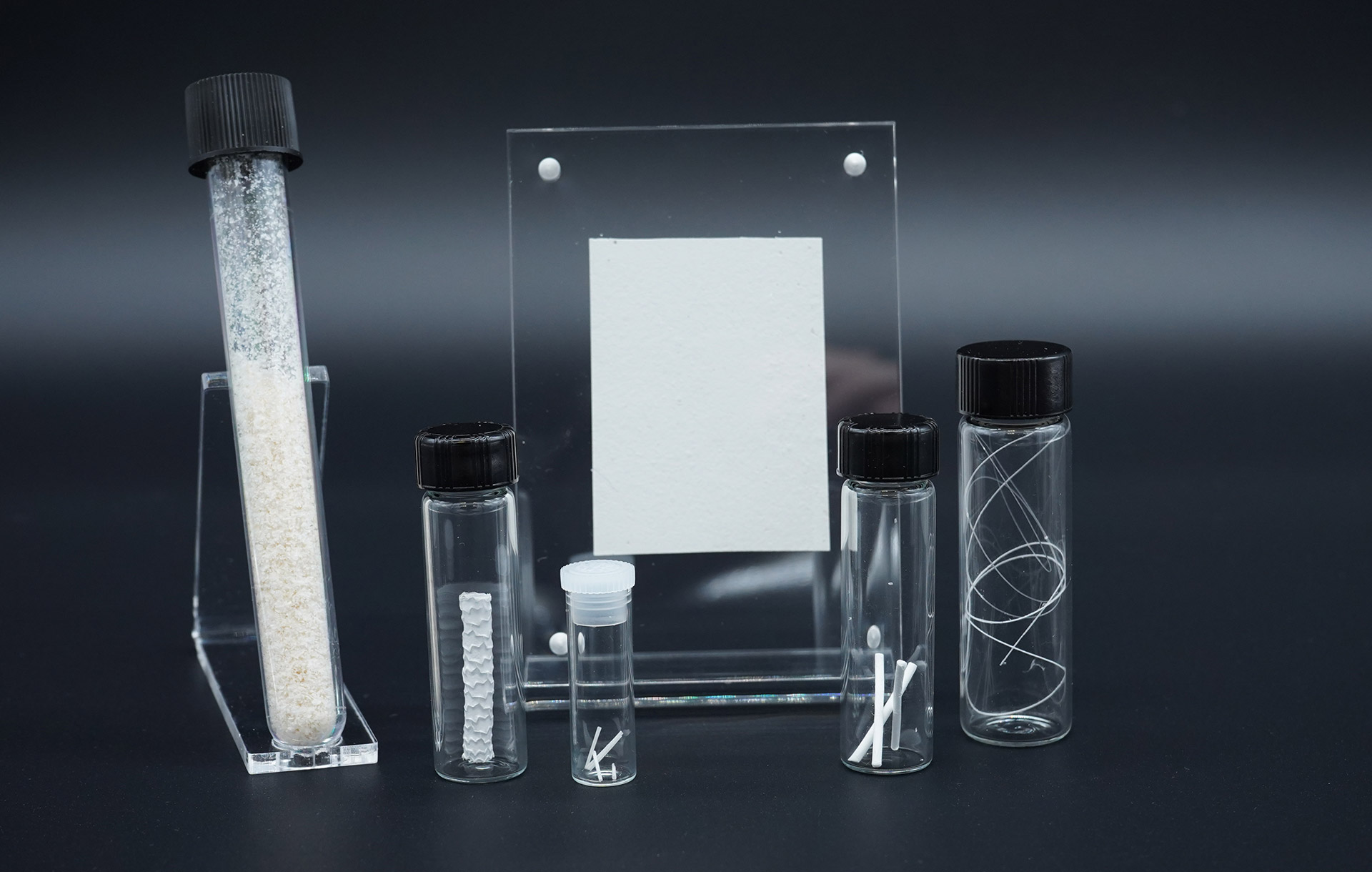Nanoparticles have revolutionized the field of biomedicine, playing a pivotal role in enhancing diagnostic and therapeutic strategies. When administered as free particles, nanoparticles face significant challenges, including rapid clearance from the bloodstream by the immune system and non-specific distribution throughout the body. These factors result in reduced effectiveness and potential toxicity. To overcome these challenges, incorporating nanoparticles into carrier systems is crucial. Electrospun nanofibers are an excellent carrier for nanoparticles due to their high surface-to-volume ratio, excellent contact and adhesion and the tunability of their mechanical and morphological properties.
Nanoparticles
Nanoparticles are widely used in various biomedical applications due to their small size, high surface area, and ability to interact with biological molecules at the molecular level. Common applications of nanoparticles in biomedicine include drug delivery, imaging and diagnostics, and antimicrobial properties. The efficacy of nanoparticles is tuned for specific applications based on the composition including polymeric, metallic, and lipid-based systems.
Polymeric nanoparticles are crafted from biocompatible and biodegradable polymers. These particles are highly versatile, allowing for the encapsulation of a wide range of therapeutic agents, including drugs, proteins, and nucleic acids. Their biodegradability ensures that they break down into non-toxic byproducts, making them safe for use in the body.
Metallic nanoparticles, such as gold, silver, copper, iron oxide, and titanium nanoparticles, are prized for their unique optical, magnetic, antimicrobial, and electrical properties. These particles are often used in imaging, diagnostic assays, and as drug delivery vehicles. Their ability to be easily functionalized with targeting ligands enhances their specificity and effectiveness in targeting diseased cells.
Lipid nanoparticles (LNPs) are biocompatible and can encapsulate and protect nucleic acids or drugs, facilitating their delivery to target cells. Their lipid bilayer structure allows for efficient fusion with cell membranes, enhancing cellular uptake.
The Importance of Incorporating Nanoparticles into Carriers
Incorporating nanoparticles into carriers for medical applications offers several advantages that can significantly enhance the efficacy, targeting, and safety of treatments. Carriers can be functionalized with ligands, antibodies, or other molecules to selectively target specific tissues and this can increase the efficiency of the nanoparticles. Targeted delivery often allows for lower doses of the therapeutic agent, further reducing the risk of adverse effects. Carriers can be designed for controlled release of their payload to ensure sustained therapeutic effect and reducing the need for frequent dosing. Nanoparticles in carriers can be protected from degradation in the bloodstream, thereby preserving their activity until they reach the target site. This approach also extends the circulation time of nanoparticles, allowing them to reach their target sites more effectively.
Electrospun Nanofiber/Nanoparticle Composites
Electrospinning is a technique that fabricates fibers by extruding a polymer solution into a highly charged electric field. This solution is propelled to a collector that is either grounded or negatively charged. As the solution travels through the electric field, solvents evaporate, and the polymer is deposited onto the collector as nanofibers that can range from tens of nanometers to several microns in diameter.1 The physical characteristics of these fibers are influenced by the electrospinning parameters and can be tuned with a high degree of control.
Nanofibers can integrate nanoparticles, serving as a carrier system that can be seamlessly incorporated into biomedical devices. The versatility of the polymer library used in electrospinning, which includes materials already approved for medical use, ensures compatibility and safety. The electrospinning process allows precise control over the loading and release of nanoparticles within the nanofibers. This control is critical for ensuring a consistent and sustained release of therapeutic agents at the target site, maximizing their therapeutic efficacy.
Functionalizing nanofibers with nanoparticles can be achieved through blended integration or decoration onto the fiber structure. Blended integration involves incorporating nanoparticles directly into the polymer solution before electrospinning, while decoration involves attaching nanoparticles to the surface of the electrospun fibers. Both techniques offer unique advantages and can be tailored to specific biomedical applications.
Polymer-Nanoparticle Blends
A facile approach for the incorporation of the nanoparticles into electrospun matrix is by creating a nanoparticle suspension in the polymer solution. The nanoparticle polymer suspension is then electrospun to form composite fibers with nanoparticles encapsulated in the fiber network. The encapsulated particles are distributed throughout the nanofiber mats. To demonstrate this, Titanium dioxide nanoparticles were suspended in a polyacrylonitrile (PAN) solution and electrospun to form nanofibers. SEM images of these fibers with incorporated metallic nanoparticles reveals regions of the particles embedded in the nanofiber matrix (Figure 1). The density of particles in the nanofibers is controlled based on the initial ratio of particles to polymers during the electrospinning process.

Incorporating nanoparticles into the polymer formulation also imparts additional benefits and characteristics to the resulting composite fiber mat that can be used towards optimizing the efficiency and performance of a medical device.2 Nanoparticles embedded into the electrospun fiber matrix can be utilized as freestanding materials, such as wound dressings or delivery platforms, or deposited directly onto existing devices. The incorporation of polymeric nanoparticles with encapsulated APIs can utilize the electrospun fiber matrix for site localized delivery and controlled release properties. Metallic nanoparticles are the most frequently incorporated material type including silver and metal oxides. Where silver nanoparticles are incorporated, they promote antibacterial activity on material surfaces. The decoration of titanium implants with titanium oxide particles promotes osseointegration of the device.
Nanoparticle-Decorated Nanofibers
A simple method for decorating electrospun fibers with nanoparticles is to make two solutions –a suspension of nanoparticles in solvent and the polymer solution. These two solutions can be electrospun coaxially with the polymeric solution extruded as core material while simultaneously ejecting the nanoparticle suspension as shell material. The density of nanoparticle decoration is proportional to the initial concentration and flow rate of the nanoparticle suspension. These parameters are independently controlled from the nanofiber production.
A blend of Poly (vinyl alcohol) (PVA) and Polyacrylic acid (PAA) was electrospun coaxial with metal organic framework (MOF) nanoparticles (Figure 2). MOFs are highly functional materials with applications as catalysts, gas sorbents, and biomaterials. SEM images of these composite nanofibers show the distribution of nanoparticles on the surface of the fibers. Affixing nanoparticles onto nanofibers creates a composite matrix that promotes high surface area and accessibility.3

Like embedded composites, nanoparticle-decorated fibers can coat or operate as free-standing materials. They can be used for drug delivery or biological detection. The high surface area from affixed nanoparticles allows for concentrated release of APIs for quick localized delivery. The photothermal properties exhibited by nanofibers decorated with calcium copper silicate nanoparticles reduce cancer cell proliferation following irradiation.
Conclusion:
Efforts to use nanotechnology to enhance biomedical applications have revolutionized biomedical industries. Nanoparticles are a key contributor to these efforts that bring forth innovative solutions in therapeutics and diagnostics. The integration of nanoparticles into various systems has proven to enhance both functionality and effectiveness. Electrospinning further expands on this potential through embedding or decorating nanoparticles, leading to advanced composite materials with highly tunable properties. Electrospinning offers tunable technology for the deposition of controlled coating thicknesses, location, and nanoparticle content in a single processing step. The versatility of these nanomaterials drives significant advancements in medical technologies that serve to improve healthcare.
References:
- Huang, J.; You, T. Electrospun nanofibers: From Rational Design, Fabrication to Electrochemical Sensing Applications. Advances in Nanofibers. 2013, https://doi.org/10.5772/57099. ↩︎
- Zhang, Y.; Lim, C. T.; Ramakrishna, S. Advances in Electrospun Hybrid Nanofibers for Biomedical Applications. Biotechnol. Adv. 2010, 28(3), 325-347. https://doi.org/10.1016/j.biotechadv.2010.01.004. ↩︎
- Saiding, Q.; Cui, W. Functional nanoparticles in electrospun fibers for biomedical applications. Nano Select. 2022, 3(6), 999-1011. https://doi.org/10.1002/nano.202100335. ↩︎

